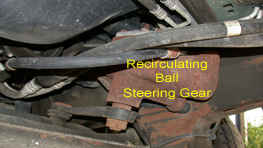
Description: The recirculating ball steering gear has been traditionally used on rear-wheel-drive cars and many light trucks. This type of steering gear uses a worm gear and ball bearings to rotate the sector shaft, which connects to the pitman arm. The rack and pinion steering gear is usually found on front-wheel-drive cars. A pinion gear moves a horizontal rack gear connected to the steering linkage. Rack and pinion steering gears are most common due to the popularity of front wheel drive. Their compact design does way with the need for an idler arm, pitman arm and center link.
Purpose: The steering gear converts and multiplies rotational force from the steering wheel into the force required to move the steering linkage, which steers the vehicle.
Maintenance Tips/Suggestions: Check the power steering fluid level at every oil change. This is also a good time to ensure that the power steering drive belt is tight. Refer to your car's owner's manual for specific recommendations on the type of power steering fluid to use. Fluids need to be compatible with hoses and seals and in some cases the recommended fluid may be automatic transmission fluids such as Type F or Dexron. The steering gear should be inspected closely at least once a year, usually at the same time as a wheel alignment, or more often as needed. The steering gear should be checked for leaks, looseness, wear, and loose mounting bolts and bushings. Symptoms of a worn steering gear include wandering, excessive play in the steering wheel, no power assist when cold, and fluid loss. If your car exhibits any of these symptoms, have it checked out as soon as possible by Kirtec Auto Services.

